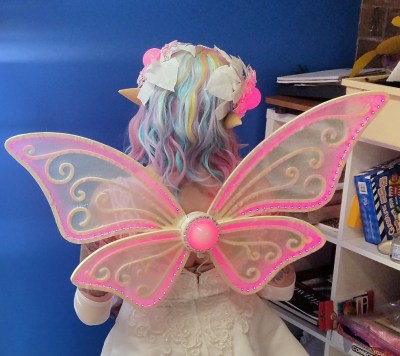As a concept, wearable technology excites many of us, but in practice, it’s been hard to nail down. Up to this point, the most high-tech thing the average person might reasonably wear has been a wrist watch. Devices like Google Glass tried to push the state-of-the-art, but it arguably raised more questions than it answered. It demonstrated in a very public way that developing wearable technology that’s simultaneously visually appealing, useful, and robust enough to handle daily life is exceptionally difficult. If Google couldn’t pull it off, what hope do we lowly hackers have?
But maybe we’ve been going about things the wrong way. Compelling as the end result may seem, the move from wrist watches to head-mounted computers is simply too large of a technical and psychological leap to make. To help develop the skills and techniques necessary to build practical wearable electronics, it might help to take a slightly more fanciful approach.
It seems to be working pretty well for Angela Sheehan, at least. In her talk “Building Whimsical Wearables: Leveling Up Through Playful Prototyping” at the 2019 Hackaday Superconference, she went over some of the things she’s learned while developing her Color Stealing Fairy costume. The product of several years of iterative design, the costume is able to mimic colors seen in the environment through the use of a wireless sensor wand, and features a number of design elements that are critical to any successful wearable project.
Even if a custom RGB Fairy costume isn’t on your short list of projects, there’s information in this talk that will surely be of interest to anyone who’s even contemplated a wearable project. From technical aspects like battery placement to logistical considerations such as making adjustments for multiple wearers, Angela’s make-believe creation has become a testbed for real-world considerations.
Bringing Imagination to Life
Angela starts her talk by saying she isn’t a programmer or an engineer, but an artist who “crash landed” into the world of wearable technology. When she started this project, her goals were more emotional than technical. She simply wanted a way to recreate magical effects like those seen in movies, particularly the enchanted color changing dress from the animated Sleeping Beauty. She knew exactly where she wanted to go with this project, all she had to do was figure out how to get there.
As such, her first piece of advice for anyone looking to start their own project is to do something that excites them. Even if it’s just for your own enjoyment and serves no practical purpose, if you’re passionate about it, you’ll have the drive to keep pushing forward when you might otherwise have given up. All the while, you’ll be increasing your personal knowledge and honing your skills.
Coming from a more artistic background. Angela perhaps had a bit farther to go but she eventually found a workflow that played to her particular strengths. Describing herself as a “two dimensional thinker”, …read more
Source:: Hackaday

